Dartmoor
Foraging and Wild Cooking in Dartmoor, South-West England
Kieran Creevy // Photography: Liz Seabrook
This is the second in our foraging and wild cooking series exploring different landscapes and ingredients within the UK. To follow the routes and for more ideas, visit Viewranger.com.
Mist still clings to the ivy-twined walls bracketing our car as we ease carefully through the narrow lanes of Devon. Passing through one small village, I sense little change in the landscape or pace of life from when I last lived and worked in this neck of the woods over a decade ago. The rumble of tyres over a cattle grid awakens the only member of our party still slumbering in the back. Now out, exposed on the open moors the rocky tors that dot the slopes and summits of many hills become more visible.
Starting up the sides of Haytor, we haven’t gone more than a few hundred metres before we come across the first of our wild edibles for todays meal – fiddlehead ferns. These vastly underrated wild greens are starting to appear in farmer’s markets across the US, but I’ve yet to encounter any in UK markets. Luckily for us, ferns colonise vast swathes of our uplands. NB: Make sure you’re 100% sure of the fern species before collecting as other ferns can be toxic. These delicate delights are at their best in spring when ferns grow their new shoots, but thanks to an extended cold snap last April, the ferns we encounter are still sprouting.
Contouring around the side of Haytor we come across one of the many quarries that dot the landscape. Nearly two hundred years ago these quarries were hives of activity, ferrying granite blocks almost ten miles via hand-cut granite and cast iron tramways to Stover canal and onwards via boat. Emerging on the far side of the hill we cross a section of the remnants of this tramway and pause to wonder about the back breaking labour and lives of the people that worked this area of Dartmoor.
ROUTE
Haytor quarry, tramway and rocks
Difficulty: Easy
Duration: 4 hours
An open moorland hike on moderate and well defined paths starting and finishing at Haytor Visitor Centre.
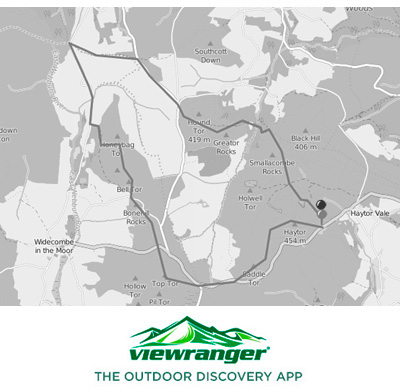
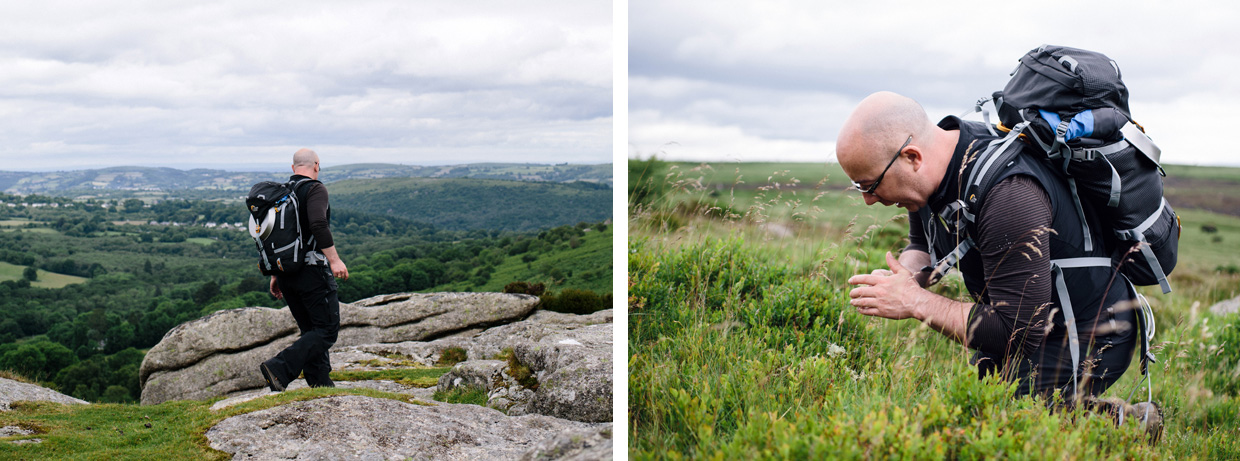
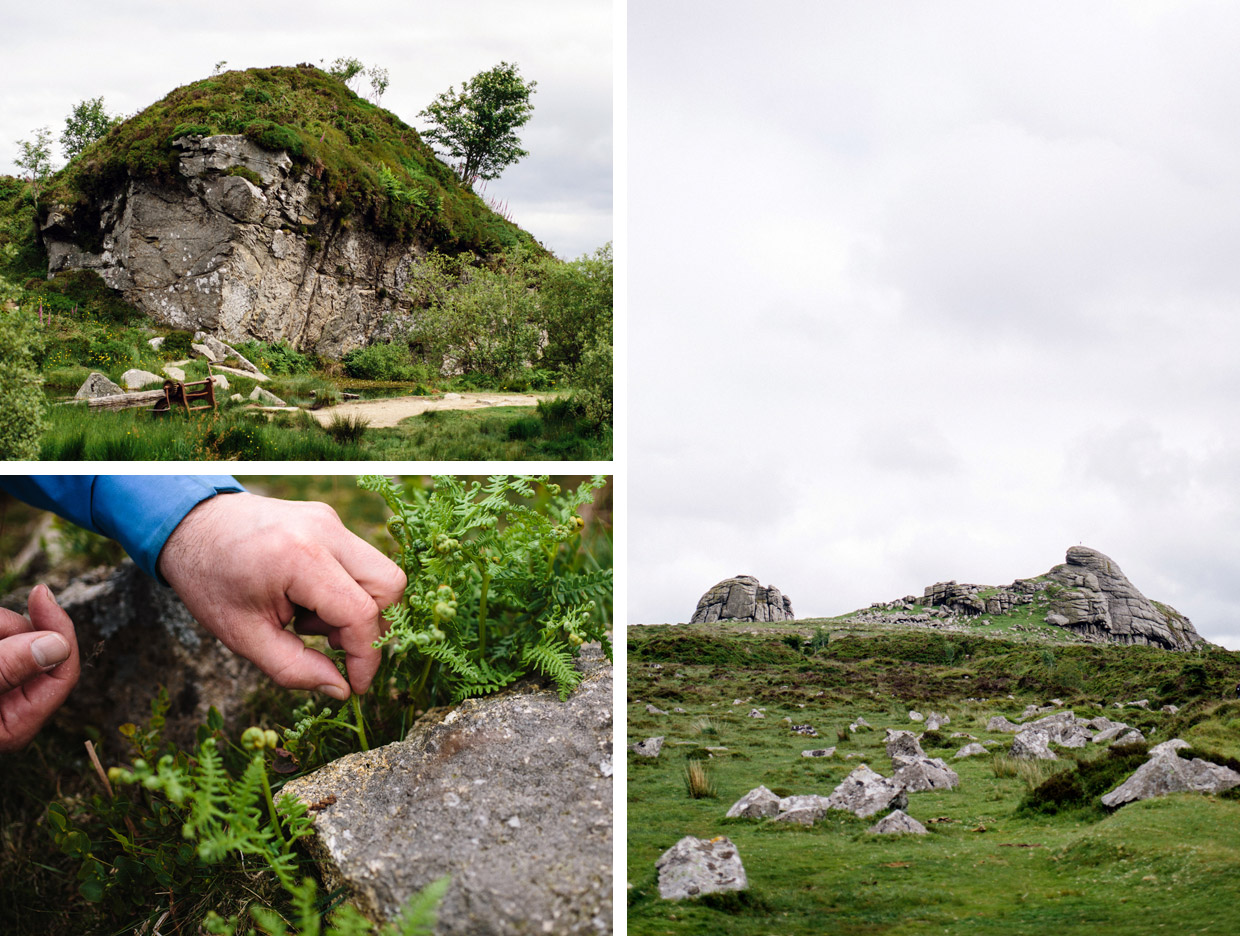
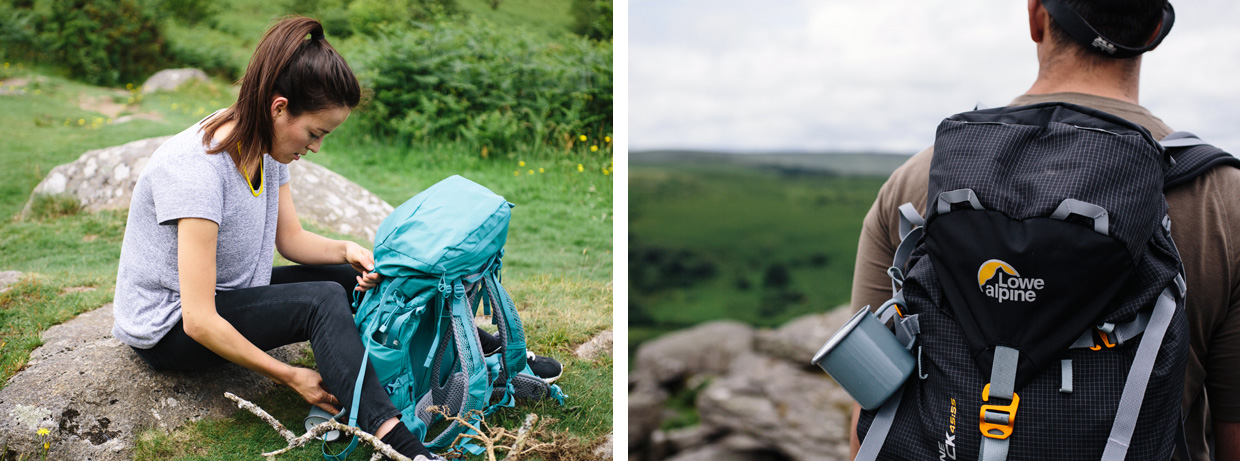
Continuing our journey we cross over Becka brook and ascend towards Greator rocks and Houndtor. Sowthistle abounds in the open areas, bright yellow flowers heralding their position.
We are surrounded by bilberry bushes but, to our disappointment, the berries are bright green and rock hard with a bitter taste – once more due to the harsh April weather. A month from now and these bushes will be bursting with dark blue and purple berries, a brilliant on-the-move snack or, as we had planned, the basis for a compote – tart with that inestimable flavour that comes from foraged edibles.
Continuing our journey we cross over Becka brook and ascend towards Greator rocks and Houndtor. Sowthistle abounds in the open areas, bright yellow flowers heralding their position. Picking these peppery, slightly bitter leaves adds another element to this evening’s dinner.
Later on, and nearing our starting point once more, we scan our maps and debate potential dinner spots. Ideas abound, but on the road, in search of fresh gooseberries, debate soon gets cut short as one of the team remembers a rocky outcrop not far down the coast that affords us the perfect outdoor dining space.
Our big cities and towns have changed almost beyond recognition in ten years, but Dartmoor and many other upland areas in England, Scotland and Wales seem to have retained their distinct character. Our National Parks are an essential part of our landscape and this status confers important rights. Having wild and open spaces upon which we can explore is, for many of us, a vital ingredient in our lives. These wild areas take us far away, physically, emotionally and spiritually from the all to crowed spaces in which we choose to live.

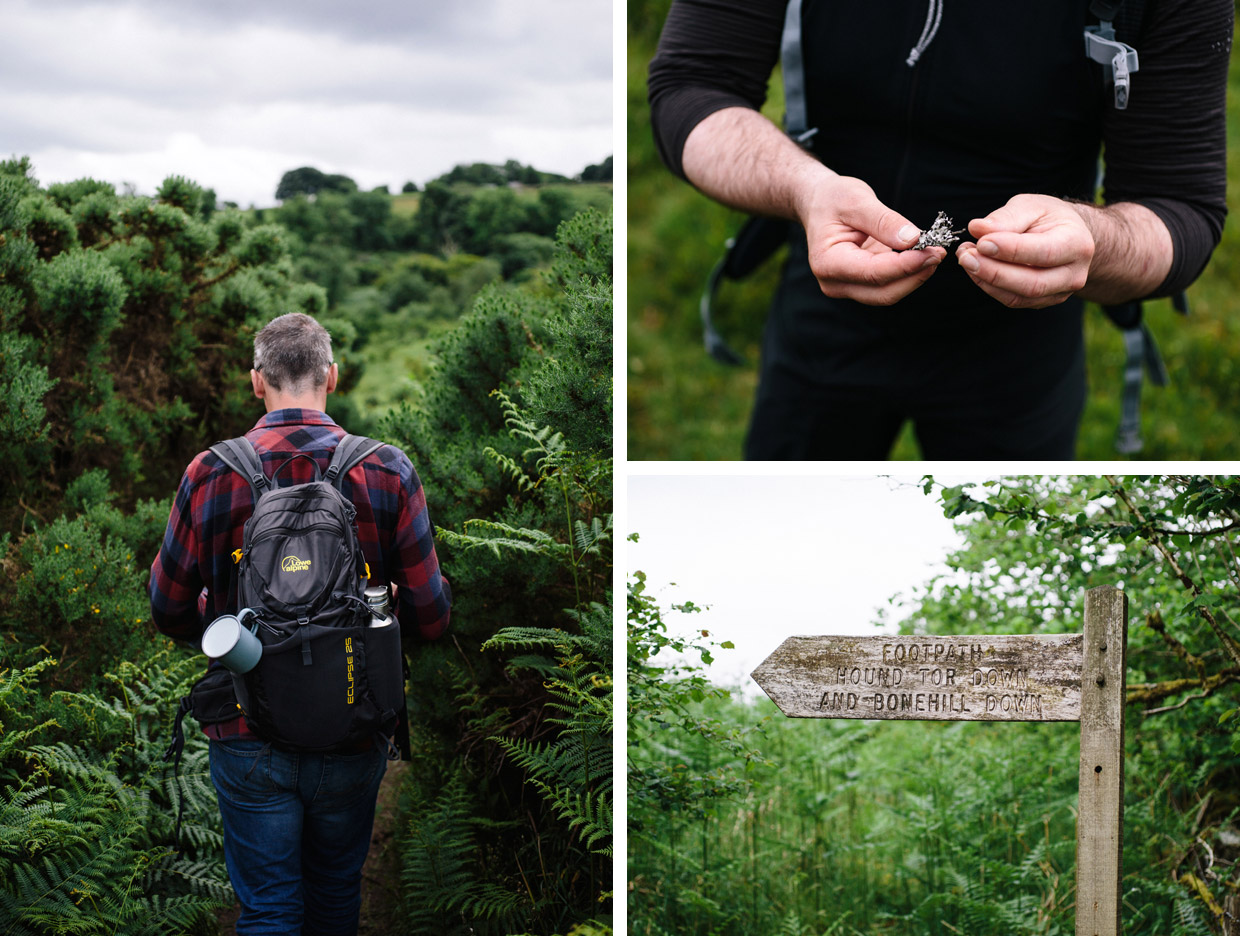
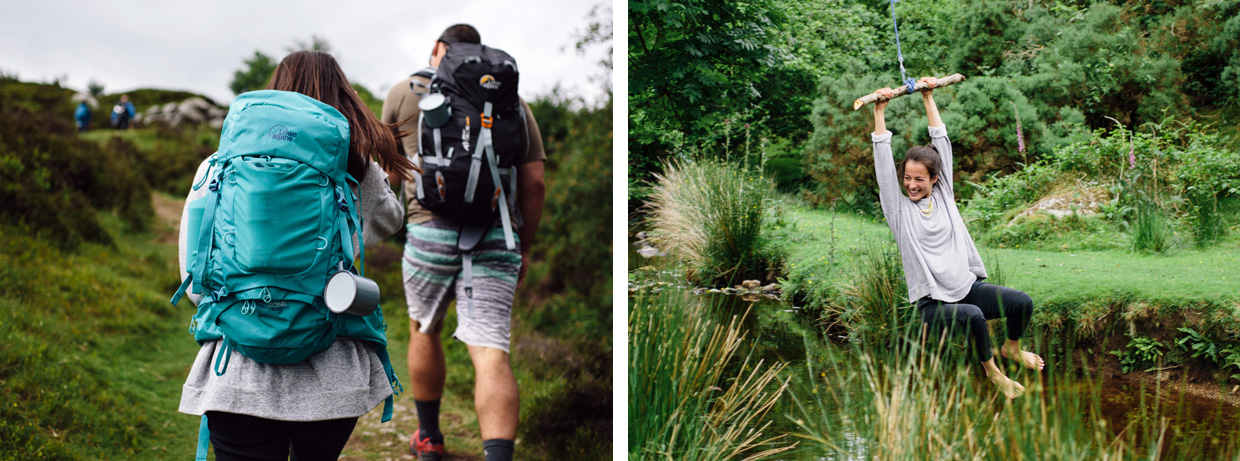
Pan fried Cod, brown butter sauce, bilberry compote, sowthistle salad, fiddlehead fern and rhubarb pickle, with caramelised hazelnuts.
Ingredients (serves four)
4 x 150 g cod fillets, skin on. Good alternatives for this dish would be mackerel, Pollock or Sea bass.
2 double handfuls bilberries. If unripe replace with fresh local gooseberries
4-6 tbsp caster sugar
1 stalk rhubarb, chopped into small chunks
2 handfuls fiddlehead fern tips (tightly curled, green only, washed and dried) 100g butter
2-3 handfuls sowthistle leaves, washed and dried
50g hazelnuts
1 tbsp whole spices (a mix of some of the following: Grains of paradise, coriander seeds, timut pepper, telicherry pepper, fennel seeds, black cardamom)
Cider vinegar
Salt
Equipment:
Stainless steel, spun iron or cast iron pan for preference
Wooden spoon, knife and fish slice if needed
Food canisters
Season the fish fillets with salt and a little pepper. Heat the pan to medium/hot and add the spices and toast until fragrant. Add 1 tbsp sugar and sufficient cider vinegar to cover the pickling ingredients. Simmer for a minute and then place the pickling ingredients in a food canister and pour over the liquid. Cover and leave to pickle whilst preparing the other ingredients.
Clean the pan, return to the heat and add the bilberries or gooseberries, 2 tbsp sugar and 2 tbsp water. Cook until the fruit splits, taste and add extra sugar if required. Don’t make the compote too sweet as it will interfere with the overall dish – you want to retain some tartness. When compote is ready, place in an insulated food canister.
Clean the pan, return to the heat and melt a generous knob of butter. Place the fish skin side down and cook for 2-3 minutes. Flip over and fry until just cooked.R emove from the pan to a dish, cover with a square of tinfoil or parchment paper and leave to rest for 2 minutes.
While the fish is resting, toast the hazelnuts in a dry pan, when toasted, pour into a container or bowl and sprinkle over 1 tbsp of caster sugar.
To serve, spoon some gooseberry compote onto each dish. Place the cod fillets on top. Pour over the brown butter sauce, add the sowthistle salad leaves, pickle and hazelnuts to the plates and enjoy.
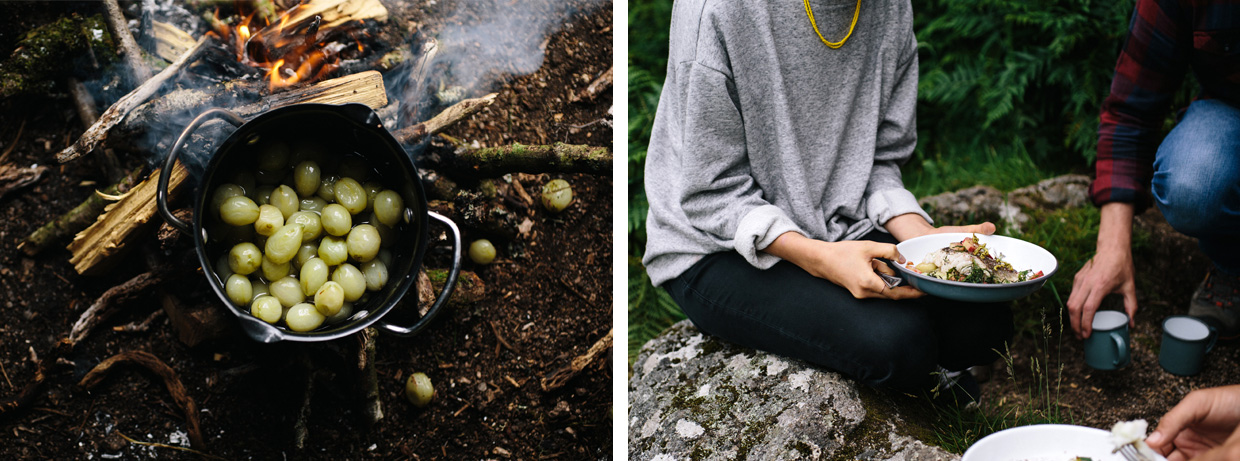

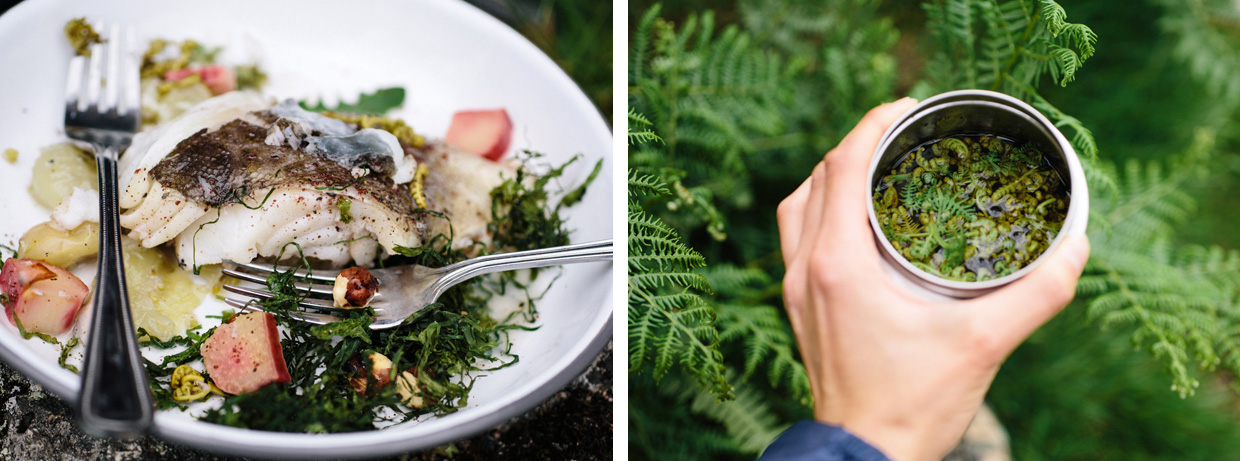
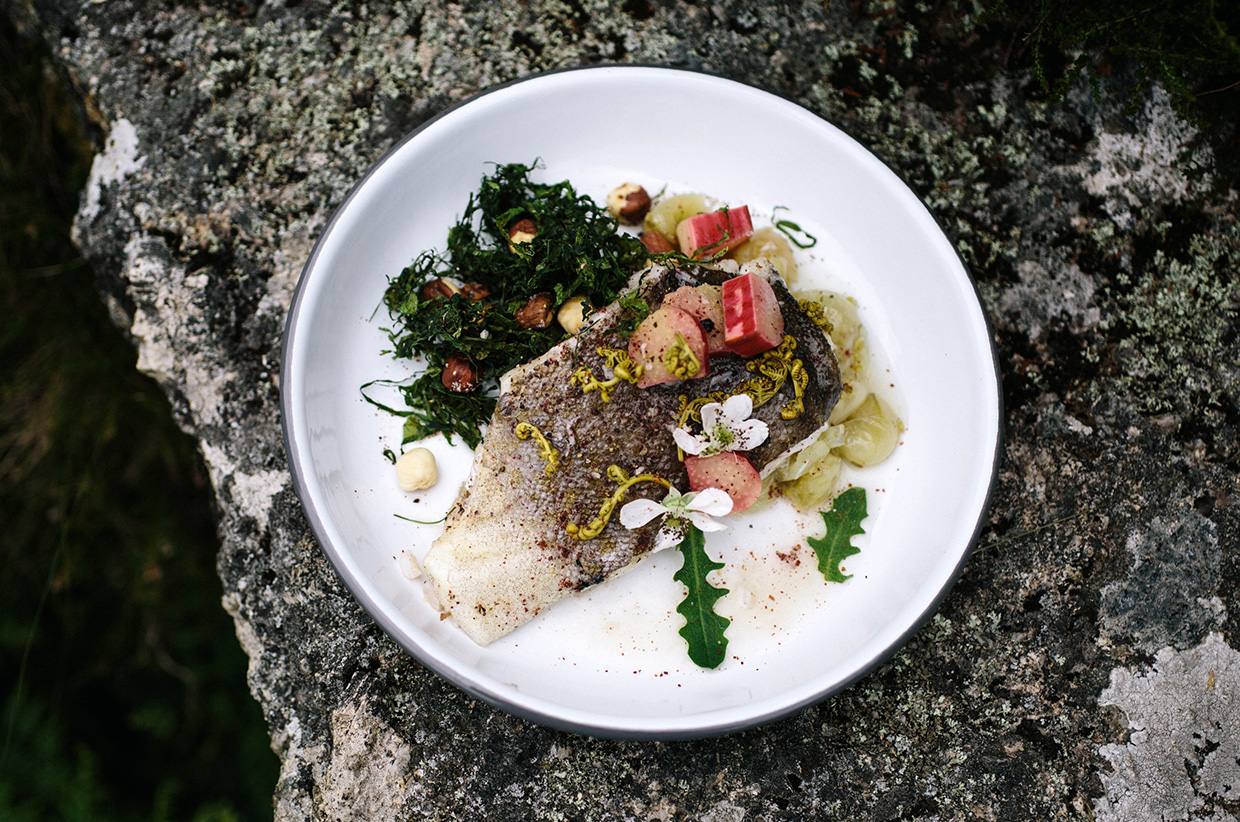
FORAGING ADVICE:
Some sources advise against eating fiddlehead ferns. We would advise that pregnant women and nursing mothers abstain from ingesting ferns. However, this is a wild edible that is eaten year round in Japan, and with the right preparation and occasional use it is unlikely to pose any risk. For more information check out Miles Irving’s The Forager Handbook, or click on the following link: http://honest-food.net/2016/04/28/bracken-fern-edible
Most land is under private ownership or owned by a state body, ask permission before foraging on someone else’s property. Familiarise yourself with the law regarding wild plants as some species are protected due to being rare, fragile, under threat or form a vital part of the ecosystem. The Theft Act 1968 outlaws the picking for commercial purposes of mushrooms, flowers, fruit or foliage from any land not owned by the picker.
Identification and Knowledge:
1. Know which plants, fruits and nuts are edible and how to correctly identify them. Do not consume unless you are 100% sure they are safe.
2. Only harvest if you can correctly identify the plant and the surrounding area is not contaminated.
3. Many plants are highly poisonous and can cause death if consumed. Many have poisonous look-a-likes.
4. It’s important to know which parts of each plant are edible.
5. Some plants are only edible after careful preparation e.g. cooking, washing, and removal of sections.
Sustainable Foraging: Where, When and How to Forage:
1. Only pick when a plant is abundant.
2. Use sharp scissors for preference, or a sharp knife.
3. Only harvest in patches, as you need to leave plants for regeneration and its continued survival.
4. Try not to remove flower or seed heads unless sourcing these specifically. Plants form a vital part of the eco-system, and many animals, insects and other organisms rely on them for survival.
COOKING ON AN OPEN FIRE
Important Note: Open fires are banned inside Dartmoor national park. If, however, you would like to recreate this dish inside the park, you can do so using a camping stove, which is allowed under the Dartmoor national park bylaws. For more information visit www.dartmoor.gov.uk
For the full experience, try to cook these dishes over an open fire or on a barbecue. If you’re making an open fire in the outdoors you need to follow a few very important rules:
1. You either need permission to have an open fire or have checked with local regulations.
2. You only need a small fire (dinner plate size) to cook these dishes. Any larger and you’re just using extra fuel for no immediate gain and you may exhaust usable wood in that area.
3. Make sure the wood you’re using isn’t going to impart an unpleasant taste to your food. Apple, Ash, Beech, Birch, Crab-apple, Chestnut and Oak are good options.
4. Only use dead wood, driftwood, or wood that has already been felled. DO NOT cut branches from living trees.
5. Make sure the wood is completely dry, inside as well as out. A simple test is to try and break a twig with one hand. If the twigs snap cleanly with no effort at all, it’s bone dry. If however it bends a lot or requires force to break, it’s still wet – even if the bark feels dry.
6. If you’re cooking over an open fire, moderate the heat under the pan by allowing the wood to cool to coals or by adjusting the height/distance from the heat source.
For in-depth fire making skills, read one of Ray Mears’ books, or check out one of the many bush craft courses available in Ireland, the UK, and around Europe and the US.




